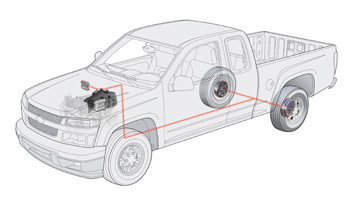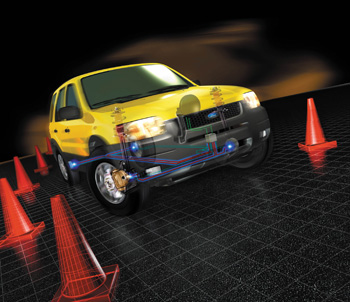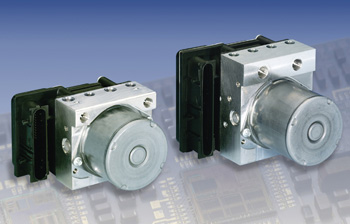 An unusual event happened at our shop: a customer actually wanted a glowing warning light on his anti-lock braking system diagnosed!
An unusual event happened at our shop: a customer actually wanted a glowing warning light on his anti-lock braking system diagnosed!
A preliminary interview revealed that: a) the ABS warning light was continuously illuminated, b) the brakes pulled to the right, and, c) the brake pedal pulsated when pressure was applied to the pedal. Noting the pulling and pulsating complaints, I cautioned the customer that the service brakes had to be operating correctly before the anti-lock portion could be accurately diagnosed. In other words, the repair would likely entail a lot more work than repairing a faulty
electrical circuit to “make the light go out.”
Since I had a full schedule ahead for the week, I referred him to a friend’s brake and alignment shop for a complete brake inspection. But the customer’s call for ABS service reminded me that, despite many earlier projections, I really don’t get that many calls for ABS service.
 My friends at the brake and alignment shop seem to share my experiences. Of course, I work in a rural market in which the ABS light may be either ignored or conveniently concealed by an inch or so of black electrical tape. On the other hand, it’s possible that ABS is so reliable that most shops aren’t experiencing a large influx of ABS repair work.
My friends at the brake and alignment shop seem to share my experiences. Of course, I work in a rural market in which the ABS light may be either ignored or conveniently concealed by an inch or so of black electrical tape. On the other hand, it’s possible that ABS is so reliable that most shops aren’t experiencing a large influx of ABS repair work.
Nevertheless, I think that most shops take anti-lock brake system maintenance very seriously. We recommend flushing the system every two years and we scrupulously inspect the service brakes for operative malfunctions such as grabbing, pulling or pedal pulsation. We also take care not to contaminate tone rings or wheel speed sensors with grease or metal chips from on-the-car machining. We also make sure that wheel sensor leads are carefully remounted in their original positions so as not to risk damage from road debris.
Stopping in for Service
While it’s true that a high-volume general repair or brake specialty shop will see its share of hard ABS failures, it’s also true that the typical shop with less than six bays may see few, if any, hard failures in the pump or valve system. Most failures, when they occur, will be in the wheel speed sensors, which exist in a relatively hazardous operating environment.
With those thoughts in mind, ABS has also tended to define the differences between the dealership and independent service markets. As opposed to the independent, dealerships usually sort out all of the teething troubles prevalent in any new technology like ABS. 
These troubles include software problems that generate false trouble codes, wiring faults, and hydraulic faults like sticking switches and valves. To diagnose these troubles, the dealer tech needs specialized equipment like a breakout box or a set of caliper pressure gauges. He also needs a detailed knowledge of each system and its potential pattern failure points to efficiently make the appropriate diagnosis.
On the other hand, when independent shops encounter a baffling ABS failure, there’s plenty of help available through brake part manufacturers, technical hotlines and Internet sources like the international Automotive Technicians’ Network (iATN). Since there are literally hundreds of ABS configurations on the market, it’s especially important to follow diagnostic troubleshooting charts or listed procedures to avoid expensive diagnostic mistakes and repetitive testing.
ABS Complaints
Of course, not all of this information is well prepared or organized in a task-oriented fashion. In one case, I worked my way through three pages of test procedures only to discover that, at the bottom of page three, the brake light fuse also supplied current to the ABS computer! On the other hand, I violated my own rule of always checking the brake lights first before getting into an extended ABS diagnosis!
Obviously, most ABS complaints can be quickly diagnosed by following a simple pre-diagnostic inspection, which may include such simple tasks as checking brake fluid level, specified tire size, equal tire circumference, condition of wheel or axle speed sensors, brake light operation, and performance of the service and park brakes.
As your experience with ABS grows, you’ll learn to look for simple failures first. Too often, when the ABS warning light illuminates, we assume that an expensive electronic failure has taken place when, in fact, an off-size spare tire is creating a false signal to the ABS computer.
On a larger scale, the anti-lock brake service business is indicative of how technology can affect the service markets. For example, since most vehicles brought into the dealership bays are usually still under warranty, the dealer technician is usually trying to solve a factory defect complaint. In most cases, the OEM complaint is caused by a single component failure. 
After all, the parts in a new car are, as you may suspect, new. So, unless it’s an obscure failure the tech is dealing with, only one part will be replaced to remedy the complaint.
On the other hand, an ABS complaint at an independent aftermarket shop working on an older vehicle may be linked to multiple failures caused by wear, abuse and neglect. The aftermarket tech may be typically confronted by a combination of worn brake pads, warped rotors, a sticking park brake lever and a broken wheel speed sensor.
In most cases, ABS systems can be serviced with ordinary shop equipment. The rare failure that demands specialized equipment can more profitably be referred to a shop that’s specially equipped for that specific service.
All in all, any shop owner must consider how much hard-failure ABS work he may encounter that will demand specialized diagnostic and repair equipment. Single- or dual-line nameplate specialty shops excluded, chances are that the majority of shops will rarely encounter an equipment-specific ABS repair.
In most cases, offering a good ABS preventive maintenance program will be all any shop will need to remain profitable in ABS services. Time and experience usually does away with the fear and apprehension created by a sophisticated technology like anti-lock brakes.











